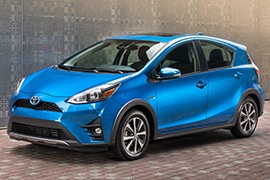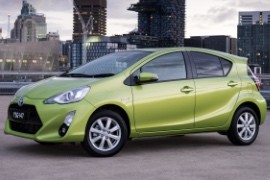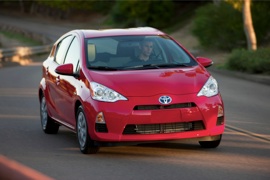TOYOTA Prius C (Aqua) Models/Series Timeline, Specifications & Photos
First production year: 2012
Engines: Hybrid
Body style: Hatchback
Toyota introduced the Prius C in 2011 as a more affordable, practical, and funky version of the well-known Prius, and by 2017 it already received a second facelift, in addition to the one introduced in 2014.
Since the Prius was already a worldwide phenomenon, Toyota considered expanding its hybrid range. So, besides the liftback version, it also launched the Prius C (from Compact) and the Prius V (V stood for Versatile) minivan. All these helped the Japanese automaker make more money from the same platform, which was a good thing since it increased the sums spent on research and the development of new products. Toyota had already led the hybrid-car industry segment and tried to keep it that way. The Prius C targeted young customers who were willing to spend less on fuel and still be able to drive a fancy-looking car. Even though it wasn’t such a statement vehicle, like the regular Prius, some might say that it was the next best thing. In a way, since it was more affordable, it really was. On the other hand, the price was reflected in many areas, especially inside the cabin. With the 2018 model year, Toyota tried to improve its compact-sized hatchback based on the Prius platform to make its customers happier.
The car’s exterior was slightly updated, and at the front, the automaker installed a new bumper that sported a more aggressive styling. Furthermore, the headlights’ shape resembled those placed on the sporty Toyota GT86, which made its young customers feel happy, even though the Prius C was on the wrong side of the near-ten-second acceleration time from 0 to 60 mph (0-97 kph). Depending on the grade, the car could be optioned with round fog lamps installed in the side scoops that flanked the apron.
From its profile, there were just a few tiny updates for the 2018 Prius C. But still, a keen eye for detail could notice the turn signal lamps integrated into the door mirrors. On the other hand, the 15-inch steel wheels with plastic caps were still part of the basic package. Toyota also suggested that the car could win the hearts and wallets of young customers by offering the Prius C with a roof spoiler mounted atop the rear tailgate and a set of high-mounted taillights that flanked the rear window. Above the license plate, in the back, Toyota added a standard reversing camera for most of the car’s trim levels.
Inside, the Prius C came with more updates than the exterior. Toyota improved the standard features on most grades, and the car came fitted with an improved touchscreen for the Entune infotainment system, which offered a higher resolution. In addition, the rear camera also displayed guiding lines, which eased parking in tight spots. Atop the dashboard, closer to the windshield, the automaker installed the multi-function display that served as an instrument panel. It also featured a new 3.5-inch color screen in the middle, which showed data for the hybrid system. It could be controlled via a few buttons mounted on the steering wheel. Moving on the passenger side, customers could find two plugs, one for a USB and another for a 3.5-mm jack for audio input, integrated into a small shelf that could host an MP3 player, an iPod, or a mobile phone. Bluetooth connectivity was standard across the range, helping the one behind the wheel stay focused on the road while taking or making calls. In addition, to help them navigate, the automaker installed a lane-keep assist system. Out back, the 60/40 split-folding bench seat was available from the second grade, named the Two, expanding the trunk.
There were no significant technological changes under the car’s skin. The same 1.5-liter Atkinson-cycle engine powered the entire hybrid system, which took its energy from a battery pack installed under the rear seats.
Toyota refreshed the Prius C for the 2016 model year and made it even more attractive to young buyers since it was better-looking and one of the most affordable hybrids on the market.
The Japanese automaker launched the Prius C as a lower-priced, city-oriented version of the Prius. It unveiled it in 2012, and by 2015, the compact-sized hybrid hatchback was ready to receive a facelift. Toyota seemed to finally understand that it had to invest more in the design department because the technology the car offered was already proven, and the carmaker’s reliability index was sky-high. As a result, it didn’t focus too much on enhancing the drivetrain and invested more in the vehicle’s overall look and features. In addition, the automaker tried to make the Prius C more attractive to younger customers who were willing to get a fuel-efficient vehicle for their daily commute. On the other hand, the dynamic factor of the Prius C was not essential, so customers couldn’t brag about the performance of their vehicles, which gave their parents peace of mind.
Despite the fact that the Prius C was not a sporty vehicle, Toyota restyled it with a more aggressive front fascia. For the 2016 model year, the car came with a hexagonal-shaped broad grille interrupted only by the horizontal slat that supported the license plate. Since both elements were black, it looked like the car had a massive front opening, ready to eat the road. The single LED projector low- and high-beam headlights were also new and offered as standard on the One trim level. In addition, on the lower side of the bumper, the automaker added a pair of side scoops that housed round fog lamps and rectangular parking lights.
From its profile, there were little things to be changed on the Prius C. The standard version came with a set of 15-inch alloy wheels, while a Sport package added a 16-inch set wrapped in low-profile tires. Thanks to the ascending curved line sculptured on the door panels; it looked closer to a hot hatch than to a fuel-efficient hybrid vehicle. Out back, Toyota installed LED taillights with clear lenses and a chromed background, making the car look sporty and stylish.
Inside, customers could find the Toyota Entune Multimedia Bundle, featuring a 6.1-inch touchscreen. For the Three grade, Toyota provided the 2016 Prius C with a same-sized touch-sensitive display with a higher resolution. It also featured a split-screen mode, six JBL speakers, SiriusXM, HD Radio, and navigation. The same screen also displayed information about the hybrid drivetrain, including recharging and drive modes. Toyota noticed that its customers were pleased with the instrument cluster placed atop the dashboard but placed the main information closer to the driving post. Customers with deeper pockets could opt for the Four trim level, which added SofTex upholstery and a wrapped steering wheel. The Prius C boasted a 17.1-cu.ft (484 liters) of space in the trunk, which could almost double when the rear 60/40 bench seat (from the Two grade up) was completely folded down.
Under the hood, things remained unchanged. The 1.5-liter gasoline engine that ran in the Atkinson cycle was efficient in charging the battery pack and keeping up with traffic speeds on the highways. While its out-of-town fuel consumption was not on par with the one provided by its Prius liftback sibling, it shined in city traffic. The 0.28 drag coefficient, which was higher than the 0.25 boasted by the regular Pirus, increased consumption at higher speeds. At the same time, thanks to the lower weight and smaller displacement ICE, the Prius C had an improved fuel efficiency over its larger sibling.
Toyota introduced the Prius C at the 2012 New York International Auto Show, a car created for the urban environment, which rewarded customers with excellent in-city fuel efficiency.
With the world financial crisis gone and more customers stepping inside Toyota’s showrooms, the Japanese automaker tried to expand its hybrid vehicles lineup. While at first sight, the Prius C was mostly a regular Prius with a different back, it was actually a reworked vehicle. It didn’t share its engine and batteries with the regular, liftback-styled Prius. Furthermore, it wasn’t designed for highway cruises but mainly for the urban commute. Another significant plus point for the car, compared with its non-C sibling, was the price, which was lower. Toyota said that it adjusted the suspension and the drivetrain of the Prius C to help it achieve lower fuel consumption within cities, hence the C letter in the car’s nameplate.
With a front fascia that didn’t share any panel with its well-known brother, the regular Prius, the C version featured triangular headlights with a step-like curvature on their lower sides. The bumper housed the carmaker’s badge, placed just above the slim and trapezoidal-shaped upper grille. Lower, on the apron, Toyota installed an additional cooling area flanked by stacked turn-signal lamps and round fog lights.
Sporting a five-door hatchback styling, the Prius C was more suitable to fit in tight parking spots. It was 460 mm (1.5 feet) shorter than its liftback sibling. Its short nose and steep windshield made room for a tall greenhouse that featured a curved roof line. At the back, the almost vertical tailgate was adorned by a roof spoiler at its upper side, flanked by clear taillights with a chromed background. Even though it didn’t get the same drag coefficient as its regular sibling, it was lighter than that, and that made the Prius C better in cities. Toyota targeted young customers, and that’s why it even offered it with a sporty-looking package that included 16-inch alloy wheels wrapped in low-profile tires as an alternative to the standard 15-inch wheels.
Inside, the dashboard didn’t look as elegant as on the non-C Prius, but it had the same design ideas. It featured an instrument panel placed atop the dashboard and close to the windshield, with the speedometer oriented towards the driver. The center stack housed the infotainment system fitted with a touchscreen and several buttons that controlled media. On the center console, Toyota placed the gear selector, which featured a PRND styling, unlike the small joystick-like shifter from the regular Prius. The Japanese automaker installed the battery pack under the rear seats, leading to a taller-mounted bench in the back, which affected headroom. Thanks to the split-folding (60/40) system, customers could expand the 17.1 cu-ft (484-liter) trunk, a helpful feature, especially for those who had to move in and out of the college.
Toyota installed a 1.5-liter Atkinson-cycle engine under the car’s hood and paired it with an electric motor. The total output of the Hybrid Synergy Drive system was 99 hp (100 PS), which was enough for a car that weighed 2,500 lbs (1,134 kg). It couldn’t win too many hearts at a drag strip, but it could be the champ in the environmental segment since it boasted a 53 mpg (4.4 l/100 km).


